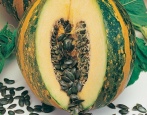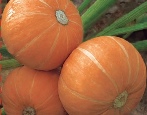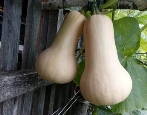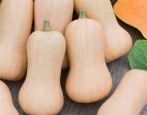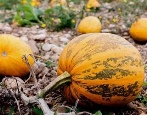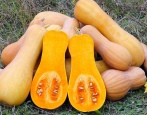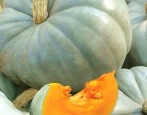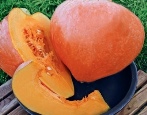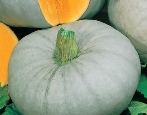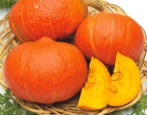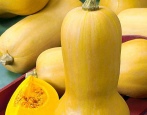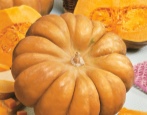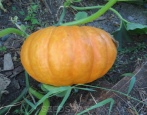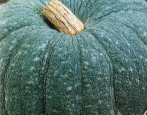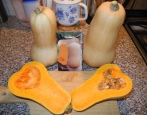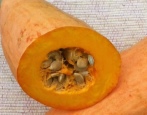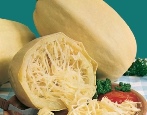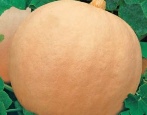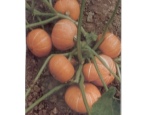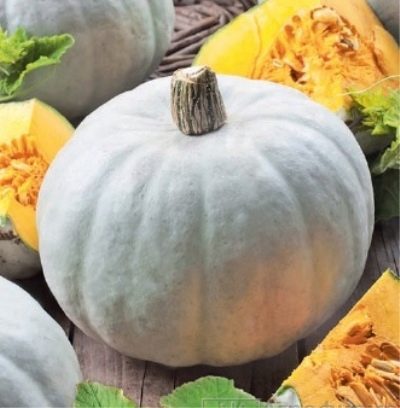
- Year of approval: 1940
- Growth type: powerful
- Lash length, m: up to 8
- Leaf shape: reniform
- Petiole: long
- Petiole length, cm : more than 25
- The form: weak or medium flattened
- Weight, kg: 6,3-9,0
- Coloration: light gray and greenish gray, no pattern
- Bark: elastic, leathery
Pumpkin Volzhskaya gray 92 is a classic variety. It was included in the State Register of Breeding Achievements in 1940. It is popular, is still in demand, and is clearly not going to give up its positions. This beautiful gray-skinned pumpkin has amazing stamina.
Description of the variety
Volzhskaya gray 92 is a large-fruited universal Russian pumpkin. The fruit grows with a very strong skin. Volga gray matures quickly enough, so it can be removed before the onset of cold weather. The pulp was great for its time. Volzhskaya gray may be inferior in sweetness to modern varieties, but its taste is still at a very good level for culture. The originators are Agrofirma Poisk and the Federal Scientific Center for Vegetable Growing.
Characteristics of the appearance of plants and fruits
Pumpkin bushes are of medium size for the culture, but they are distinguished by vigorous growth. Scourges are long, up to 8 meters, with large leaves on petioles from 25 cm long.
Fruits are round, slightly flattened. The average weight of one pumpkin is 6.3-9 kg, but with good agricultural technology, fruits up to 20 kg can be obtained. Segments are poorly expressed, but well read. The bark is gray or gray-green in color, smooth, leathery, officially described as unpainted. But you can often see slight marbling on the surface.
The pulp is bright, the color of the pulp is similar to the color of the yolk of village eggs, it contrasts very strongly with the crust. The density of the pulp is average, the thickness is from 4 to 4.5 cm. The seed nest is large, the seeds are medium in size. Keeping quality is up to 5 months. Over time, the starch in the pulp turns into sugar, the pumpkin becomes sweeter. It tolerates transportation well.
Purpose and taste
The taste is good. The variety belongs to the category of medium sweet pumpkins. The pulp is juicy, does not knit at all when ripe. The seeds have a great taste. The application is universal. Pumpkin is grown for both pulp and seeds. The pulp is used for the first and second courses, cereals, juices, mashed potatoes, vegetable caviar. The seeds are dried and used for culinary and medicinal purposes.
Ripening terms
Volzhskaya gray 92 is a mid-season variety. The fruits are harvested 102-121 days after the emergence of mass shoots. Cleaning takes place in August-September.
Yield
The standard indicator is 17.9-35.2 t / ha. From 1 bush, usually a couple of fruits are obtained, everything depends on the conditions.
Growing regions
Pumpkin Volzhskaya Gray has successfully spread throughout Russia, but it is best grown in regions with long and warm summers: the North Caucasus, the Volga region. It grows well in the Urals through seedlings. Like any melons, does not like cold and dampness, prefers dry hot weather.
Growing and care
Variety Volzhskaya gray 92 is unpretentious, tolerates drought well. Plants are planted at a distance of 60 cm from each other. The timing of planting seeds or ready-made seedlings in the ground is late May-early June. If the seedling method is chosen, the seeds are sown in individual large packages in April. In the aisles, a distance of 60 cm is also made.
To obtain large fruits, high-quality care is desirable:
- abundant and careful watering;
- regular feeding for the size and taste of the fruit;
- removal of all unnecessary ovaries.
For watering, it is better to organize grooves, trenches or watering circles, so there is no risk of depriving some of the bushes, and others - overflowing.Pumpkins do not like getting moisture on the stems and leaves. Watering is desirable once a day, in the evening. An adult plant of Volzhskaya sulfur 92 will require at least 10 liters of water. The approximate amount of water is calculated based on the total planned mass of fruits + 10% for the needs of the bush. This amount varies depending on the weather and natural precipitation.
It is best to fertilize with organic matter: wood ash (1 tablespoon per well before planting seeds), slurry (1 part to 10 parts of water), chicken droppings (1 part to 20 parts of water), grass infusion (1/3 of a barrel filled with green mass on 200 l, allowed to ferment for 1 week). For 1 bush, 2 liters of solution are needed, during the period of fruit pouring - 3 liters. They are fed 1-2 times a month.
When feeding with mineral fertilizers, the dosage is carefully monitored. Overfeeding with nitrogen provokes powdery mildew. Fertilization is last applied 45 days before the approximate harvest date.
Pumpkins Volzhskaya gray 92 can be stored in an ordinary apartment at room temperature. Only damage to the bark can affect keeping quality. All scratches and the tail are carefully covered with brilliant green.
Requirements for soil and climatic conditions
Pumpkins love loose, fertile, neutral or slightly acidic soil (pH 6.5-7.0), spacious sunny places without stagnant moisture. Grow well on compost heaps, high ridges. When planting, the soil temperature should be from + 13 ° C. The optimum air temperature is from + 20 ° С.
Disease and pest resistance
The variety is moderately resistant to powdery mildew and fusarium wilt. It is better to thoroughly treat soil for seedlings and seeds with "Fitosporin" or any fungicides in advance. The pumpkin is relatively resistant to decay of fruits: the leathery and very dense crust protects the pumpkin from damage. To protect against snails, which are very attracted to pumpkins, ground eggshells or mustard powder are poured into the aisles.
Review overview
Long-leafed pumpkin varieties are not very popular today, but if you need a very hardy variety, Volzhskaya gray 92 is remembered first. There are a lot of reviews about the variety, mostly positive. Very tasty, ripens even in difficult climates, seed germination is simply amazing. In a few critical reviews, the main complaints are about taste. The pumpkin is not too sweet. There are complaints about the pulp: its layer is too thin. Some gardeners drew attention to the too thorny stems, while others noted that young plants attract all slugs and snails from the garden.
But most gardeners like the taste, it is sweet and delicate. Some have compared the taste of pumpkin to a turnip, only without bitterness. The main advantages: the availability and price of seeds, endurance, the ability to grow the variety in areas of risky farming.
